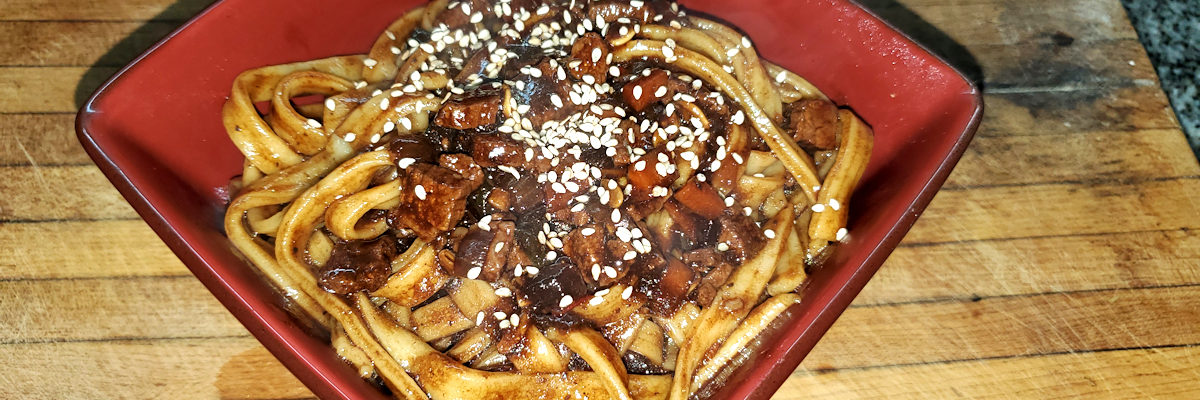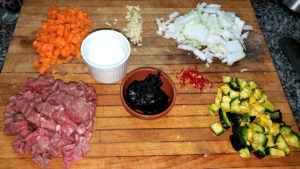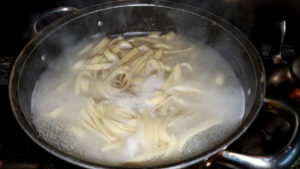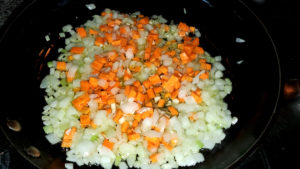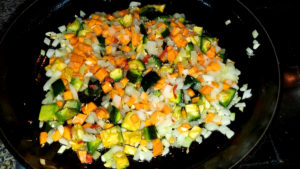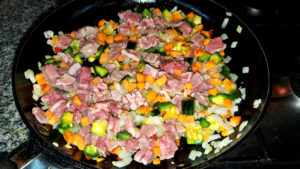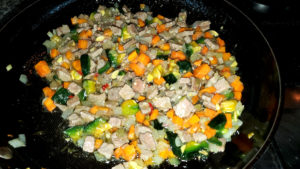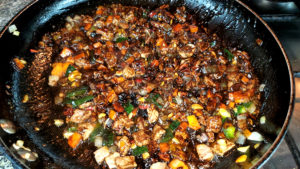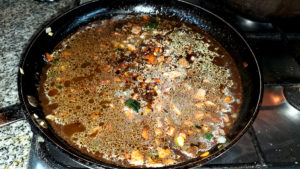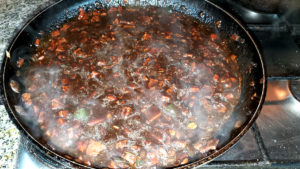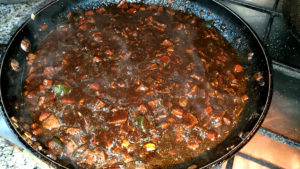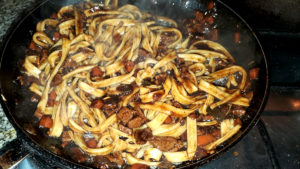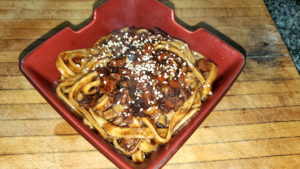I’ve talked a bit before about junghwa yori, or Korean-Chinese fusion cuisine, and presented a little excerpt from Wikipedia a while back on how it all came about, in a nutshell. One of my favorite dishes of the genre, and sort of my litmus test for a new spot, is jajangmyeon (literally, “fried” “sauce” “noodles”), a noodle dish made with vegetables, usually meat (though that’s not a requirement), and fermented black bean paste. Now, I realize that most of you probably don’t have a package of fermented black soybean paste in your pantry. If you do, we should definitely be friends. But, that aside, I thought I’d offer up a basic guide to how to make the dish, should you ever find yourself with such a package.
I’ve seen a few recipes that offer the use of doenjang (“thick” “sauce”), the Korean fermented soybean paste (generally made with white or lighter colored soybeans), in this dish, noting that the flavors will be somewhat different, but that it works. Doenjang is similar to miso, though not exactly the same, so I’d bet that you could make a similar dish using miso paste – something more of you are likely to have on hand.
This was enough to make about 3 portions. 1 large carrot, 2 cloves of garlic, 1 large onion, 1 large green squash (zucchini, globe squash, summer squash), a chili, all chopped, plus some beef (this can also made with pork, chicken, seafood, or leave the meat out entirely), about 3 tablespoons of the bean paste, and some cornstarch “slurry” (a heaping tablespoon of cornstarch dissolved in a little water). Traditionally, there would likely also be a diced up potato, but we’ve been eating so many potatoes, and with the noodles coming into this, I just wanted to cut back on the starch. The vegetables also vary, depending on whose recipe you’re looking at, other than the onion and garlic.
I want to touch on the noodles for a moment. I’ve seen, in various restaurants, various types of noodles used. Generally, they’re slightly thicker ones, but I’ve also seen this sauce tossed with spaghetti and somen noodles, so that’s not an absolute. I happened to be watching an episode of the current Korean food drama I’ve been watching, and the chef offered up his “secret” to making the noodles have the right chewy texture, which is to substitute some portion of the pasta flour with cornstarch, and to dry the noodles well before boiling. He didn’t give any percentages, but a bit of research online suggested an amount that seemed to come out roughly in the 15-20% range. So for our three portions, instead of a cup and a half of flour or semolina, I used a cup and a quarter, and then a quarter cup of cornstarch – 1/6, or 16.6% – and I left the noodles on the drying rack all day. It worked! I also rolled these out slightly thicker than normal (level 5 instead of 6 on my hand cranked machine).
In a saute pan, saute the onions in a couple of tablespoons of oil over medium-high heat until softened.
Add the carrots and garlic and saute a couple of minutes more.
Add the squash and chili, and another couple of minutes.
Add the beef or other protein, and saute until browned. The exception to this would be if it’s seafood, which all the recipes say to set aside and add at last minute because it cooks so fast.
Cook until lightly browned, just a minute or two.
Add the black bean paste, stir well to coat.
Cover with water – for this amount, I used about two cups of water.
Bring to a boil, turn the heat down to low and let it simmer away until somewhat thickened and the water is down to a sort of “stew-like” level. This would be the point I’d add in the seafood if I was using it, and just cook for a couple of minutes longer until the seafood is cooked in the sauce.
Re-mix your cornstarch slurry as the cornstarch will settle out to some extent while sitting there, and add to the pot. Stir well, cook just a minute or two until the whole thing thickens and gets shiny.
Toss with the noodles. In a restaurant setting, the sauce is usually ladled on top of a mound of noodles, which are sometimes tossed with a little butter, and each person mixes up their own bowl. But that’s theater… we’re at home. Toss it all together.
And, serve. Normally it’s garnished with a julienne of cucumber for freshness to cut the richness, but our corner market didn’t have any cucumbers. And, sesame seeds. Enjoy!
